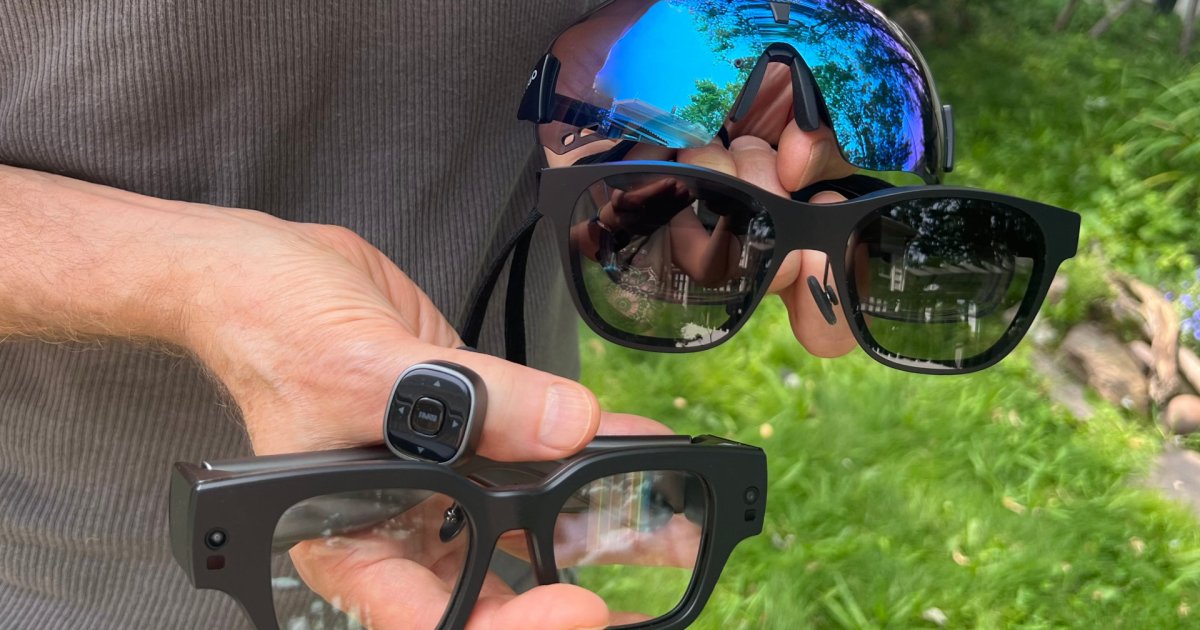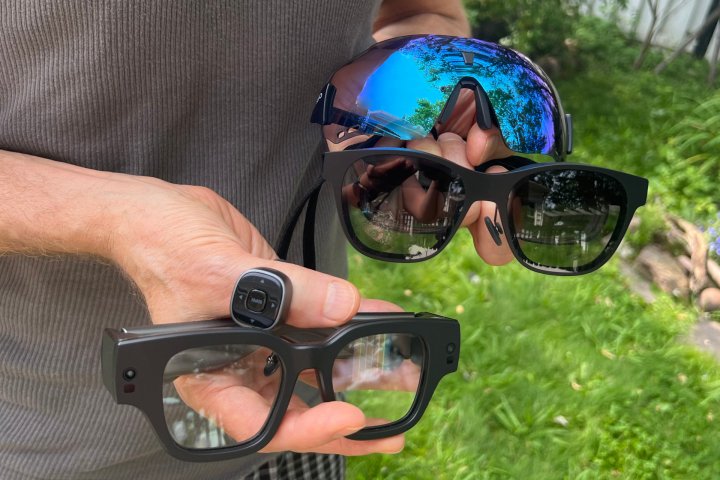Are AR glasses still a pipe dream? I tested 3 of the newest to find out
I tried three different smart glasses with unique and exciting features, some with AR capabilities -- here's what I learned.

 Photo by Tracey Truly / -
Photo by Tracey Truly / -The augmented reality future we’ve all been dreaming of is still years away. I’m not here to debate that. But the hardware and software that currently exists has continued to improve. Early adopters are already enjoying lightweight glasses with sharp, bright displays, and some recent products demonstrate the progress made on that long path to AR glory.
I wanted to take stock of the current generation of smart glasses technology, complete with three different approaches. One is a stylish, fitness-focused pair of glasses that provides health-tracking data and directions at a glance. Another is all about entertainment and productivity, made possible with three large virtual screens around me. And then finally, the one that puts them all together in the most advanced smart glasses currently available, with a dedicated processor for AI chat, AR apps, and gesture controls. None provide the full picture of AR technology, but each offer a glimpse at the future of smart glasses — and it’s pretty exciting.
Engo 2 fitness glasses
 Engo 2 glasses are very light, comfortable, and sporty. Photo by Tracey Truly / -
Engo 2 glasses are very light, comfortable, and sporty. Photo by Tracey Truly / -Let’s start with the Engo 2. These are smart glasses that look and feel like regular sport sunglasses — and that’s precisely what they are meant to replace. They look nice and are incredibly lightweight at 36 grams for the standard size and 41 grams for large. I tried the standard size and felt like I could wear these all day without issue.
The concept behind Engo 2 is to provide exactly as much technology as needed with maximum battery life and minimum weight while keeping the price affordable. Engo 2 are currently the lightest smart glasses I know of that have a actual display.
Engo 2 pairing was easy. I downloaded the ActiveLook app to my iPhone. I can pair an Apple Watch to run or bike, but my Apple Watch doesn’t have cellular, so I took my iPhone.
A third-party Cosmo Connected app allows the Engo 2 to show turn-by-turn directions, speed, and distance traveled. Cosmo makes smart accessories for cyclers, so the intention is to use this feature when riding a bike. However, Cosmo Connected directions also work when I walk, run, or ride in a car to my destination.
 Engo
EngoThe Engo 2 display is quite small, but data appears in a crisp, bright yellow overlay at the top left corner of the right lens. Despite the limited size, I can clearly see everything I need when running.
Heart rate, distance, speed, and time are the standard metrics used, all of which can be customized, so I can have quick access to altitude, elevation, power, pace, and cadence.
After setting up alternate views, a wave of my hand switches between views while my iPhone stays in my pocket. Seeing everything without raising my arm and glancing at my watch keeps me in the flow during a workout.
Priced at $329, the Engo 2 is best-suited for runners, bikers, and fitness enthusiasts. I’m more of a weekend warrior and occasional runner, but I still found use in having real-time access to those stats.
These are well-optimized and targeted smart glasses that set a good standard for specialized use. Vuzix Ultralite takes a similar approach. Simplicity and reliability are a winning combination, and with the current technology available, are the safest way into the world of AR glasses.
Xreal Air and Beam
 Xreal Air is lightweight and comfortable enough for hours of use. Photo by Tracey Truly / -
Xreal Air is lightweight and comfortable enough for hours of use. Photo by Tracey Truly / -The Xreal Air and Beam accessory, though, are quite a bit more ambitious. These are more than just a heads-up display — rather, aiming to extend your work canvas into the virtual world right over your vision. This combination is an excellent solution for watching videos, playing games, and making productivity portable.
The Xreal Air is a popular solution for compatible Android phones, but iPhone owners once had to use two bulky adapters to connect. The new Beam accessory provides a wireless connection to my iPhone and many other devices.
Xreal also gave a special incentive to MacBook owners, the Nebula app that simulates up to three giant virtual monitors. Nebula is now available for Windows in beta testing, making these smart glasses with AR features more capable and compatible than ever before.
 Alan Truly / Digital Trends
Alan Truly / Digital TrendsThe screen is sharp and bright enough for use outdoors when it’s overcast. Colors are vivid, if somewhat oversaturated, but the picture looks nice overall. Sound comes from speakers in the earpieces. Volume and quality is good.
At $379, Xreal Air is a powerful, portable display that simulates a 130-inch screen. The $109 Xreal Beam expands connectivity. Beam optionally anchors the virtual monitor in space, so I can look at it or turn away, and the screen remains fixed where I place it.
At 79g (2.79oz), Xreal Air is heavier than standard glasses but still relatively light. Three nosepiece sizes are in the box, and the lenses tilt to maximize comfort.
The Xreal Air has a broad appeal, and the new Beam accessory and Nebula for Windows should make it even more popular. It’s an intriguing option for anyone operating in limited spaces, a giant screen that fits in a pair of foldable glasses. It’s not all that different of a promise than what Apple is making with its Vision Pro mixed-reality headset.
Inmo Air 2
 Inmo Air 2 has its own processor, so you don’t need a computer or smartphone. Photo by Tracey Truly
Inmo Air 2 has its own processor, so you don’t need a computer or smartphone. Photo by Tracey TrulyInmo makes the most advanced smart glasses I’ve tested. The Inmo Air 2 includes a mobile processor, thin and transparent micro-LED waveguide lenses, a built-in battery, speakers and touchpads on each earpiece, a controller ring, and cameras.
Inmo Air 2 comes with twelve apps pre-installed. YouTube and TikTok TV provide solid entertainment. A camera app lets me capture photos and videos. The quality isn’t as good as my iPhone or Google Pixel, but the first-person perspective is unique.
At home or anywhere Wi-Fi is available, I can use the glasses without a smartphone. When traveling, I can create a hotspot with my smartphone to connect the Inmo Air 2.
InmoGPT is an AI assistant that helps with various tasks. It’s a wrapper for ChatGPT that allows you to speak a question or command. The answer appears on-screen. There will be a small charge for use. According to the Kickstarter campaign, the cost will be about $6 per 1,000 interactions.
 Inmo Air 2 is bright enough for outdoors with the clip-on sunshade. Tracy Truly / Digital Trends
Inmo Air 2 is bright enough for outdoors with the clip-on sunshade. Tracy Truly / Digital TrendsThe translation app can help when learning a new language. Languages currently supported include English, Spanish, French, German, Italian, Russian, Chinese, Japanese, Cantonese, and Korean.
There are also apps for meetings, viewing the gallery, screencasting, and turn-by-turn directions. The last two require a smartphone connection. Inmo Air 2 is compatible with my iPhone and Google Pixel.
Inmo Air 2 also has the most advanced display, a waveguide that’s almost invisible when viewed from the front. The screen is bright enough for indoor use. Outdoors, I used clip-on shades to darken the scenery, making the screen brighter by comparison. The sharpness and color accuracy it very good.
Battery life is usually a concern for wireless smart glasses. Inmo claims the Air 2 has up to 5.5 hours of battery life. I didn’t wear them for that long, but the estimate seems reasonable in my experience.
The touchpads on each earpiece work well, and I can swipe up, down, left, and right to navigate through YouTube, TikTok TV, and the operating system. A chunky ring provides a joypad-like controller, but I prefer the touchpads.
Weight is about the same as Xreal Air. The Inmo Air 2 is comfortable for several hours using the included choice of three nosepieces.
The Kickstarter price is $599, with a retail price of $799. That makes Inmo Air 2 the most expensive smart glasses on this list, but the device is packed with technology, and is the most compelling look at what AR glasses could be in the future.
Inmo Air 2 pushes the limits of what’s possible with smartphone-like technology built into a pair of smart glasses. The app store isn’t active yet, but several apps come pre-installed. The display isn’t as bright or large as the Xreal Air, but it’s still big. I’d estimate it as equivalent to a 50-inch monitor.
Smart glasses aren’t AR glasses
 Meta
MetaDespite these great options for smart glasses, none are true AR glasses. Enterprise-grade solutions already exist, providing hand-tracking, object tracking and recognition, virtual keyboards, and several more advanced features. The trade-off is that such devices are bulky and heavy, making them unattractive for everyday use.
The technology is simply not available to achieve these wonders in a slim, light glasses form factor right now. But progress is being made. Qualcomm announced its Snapdragon AR2 Gen 1 processor and devices using this technology could launch in 2024, if not sooner.
Looking further down the road, Lumus is working on advanced, full-color AR glasses for targeting late 2024 or 2025. Meta AR glasses are in development, and Apple AR glasses are planned as well.
It won’t be long before AR glasses arrive in full form, and even from these early looks at the technology, it’s looks primed to be the next big revolution in computing interfaces.

 JimMin
JimMin 






























